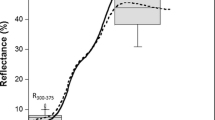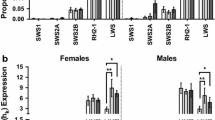Summary
Experiments were designed to determine the effects of male pigmentation patterns on female choice in guppies. When presented with a series of variably-colored males, females of different genetic strain consistently exhibited similar preferences (Tables 1 and 2), preferring those males with the greatest development of both carotenoid and iridescent pigments (Table 3). A partial rank correlation analysis of pigments of males indicates positive correlations between the iridescent and carotenoid pigments and also between melanins and showiness (Table 4). Only when either the carotenoid or iridescent pigments were held constant was there any effect of the other pigments on the ranking order of males by the females. Other pigments appear to be relatively unimportant in influencing female choice of males. These results indicate that females discriminate among males on the basis of color and that females of different strains prefer the same male colors rather than those characteristics of males of their own strain. The results support those models of sexual selection that hold that sexually selected traits honestly advertise the phenotypic and genetic qualities of males; they do not support models of runaway selection for particular male traits, such as first proposed by Fisher (1930).
Similar content being viewed by others
References
Andersson M (1982) Sexual selection, natural selection and quality advertisement. Biol J Linn Soc 17:375–393
Baerends GP, Brouwer R, Waterbolk HTJ (1955) Ethological studies on Lebistes reticulatus (Peters) I. An analysis of the male courtship pattern. Behaviour 8:249–334
Bell G (1978) The handicap principle in sexual selection. Evolution 32:872–885
Borgia G (1979) Sexual selection and the evolution of mating systems. In: Blum MS, Blum NA (eds) Sexual selection and reproductive competition in insects. Academic, New York pp 215–223
Deufel J (1975) Physiological effect of carotenoids on salmonidae. Hydrologie 37:244–248
Emlen ST, Oring LW, (1977) Ecology, sexual selection and the evolution of mating systems. Science 197:215–223
Endler JA (1978) A predator's view of animal color patterns. Evol Biol 11:319–364
Endler JA (1980) Natural selection on color patterns in Poecilia reticulata. Evolution 34:76–91
Endler JA (1983) Natural and sexual selection on color patterns in poeciliid fishes. Environ Biol Fish 9:173–190
Farr JA (1976) Social facilitation on male sexual behavior, intrasexual competition, and sexual selection in the guppy, Poecilia reticulata (Pisces: Poeciliidae). Evolution 30:707–717
Farr JA (1977) Male rarity or novelty, female choice behavior, and sexual selection in the guppy, Poecilia reticulata (Pisces, Poeciliidae). Evolution 31:162–168
Farr JA (1980) Social behavior patterns as determinants of reproductive success in the guppy, Poecilia reticulata Peters (Pisces, Poeciliidae). Behaviour 74:38–91
Fisher RA (1930) The genetical theory of natural selection. The Clarendon, Oxford, pp 272
Fox DL (1976) Animal biochromes and structural colours. University of California Press, Berkeley, p 433
Fujii R (1969) Chromatophores and pigments. In: Hoar WS, Randall DJ (eds) Fish physiology, vol 3. Academic, New York, pp 307–353
Hamilton WD, Zuk M (1982) Heritable true fitness and bright brids: a role for parasites? Science 218:384–387
Harma T, Hasegawa H (1967) Studies on the chromatophores of Oryzias latipes (teleostean fish): Behavior of pteridine, fat and carotenoid during xanthophore differentiation in the color varieties. Proc Jpn Acad 43:901–906
Haskins CP, Haskins EF (1951) The inheritance of certain color patterns in wild populations of Lebistes reticulatus in Trinidad. Evolution 5:216–225
Haskins CP, Haskins EF, McLaughlin JJA, Hewitt RE (1961) Polymorphism and population structure in Lebistes reticulatus, a population study. In: Blair WF (ed) Vertebrate speciation. University of Texas Press, Austin, pp 320–395
Hildemann WH, Wagner ED (1954) Intraspecific sperm competition in Lebistes. Am Nat 88:87–91
Kirkpatrick M (1982) Sexual selection and the evolution of female choice. Evolution 36:1–12
Kodric-Brown A, Brown JH (1984) Truth in advertising: the kinds of traits favored by sexual selection. Am Nat 124:309–323
Land R (1980) Sexual dimorphisms, sexual selection, and adaptation in polgenic characters. Evolution 34:292–307
Liley RN (1966) Ethological isolating mechanisms in four sympatric species of Peociliid fishes. Behaviour (Suppl) 13:1–197
Maynard Smith J (1976) Sexual selection and the handicap principle. J Theor Biol 57:239–242
Nur N, Hasson O (1984) Phenotypic plasticity and the handicap principle. J Theor Biol 110:275–297
O'Donald P (1980) Genetic models of sexual selection. Cambridge University Press, Cambridge, pp 250
Quantz G (1980) Über den Einfluß von carotinoidreichem Trockenfutter auf die Eibefruchtung der Regenbogenforelle (Salmo gardneri R). Arch Fischereiwiss 31:29–40
Winge O, Ditlevsen (1947) Colour inheritance and sex determination in Lebistes. Heredity 1:65
Zahavi A (1975) Mate selection — a selection for a handicap. J Theor Biol 53:205–214
Author information
Authors and Affiliations
Rights and permissions
About this article
Cite this article
Kodric-Brown, A. Female preference and sexual selection for male coloration in the guppy (Poecilia reticulata). Behav Ecol Sociobiol 17, 199–205 (1985). https://doi.org/10.1007/BF00300137
Received:
Accepted:
Issue Date:
DOI: https://doi.org/10.1007/BF00300137




